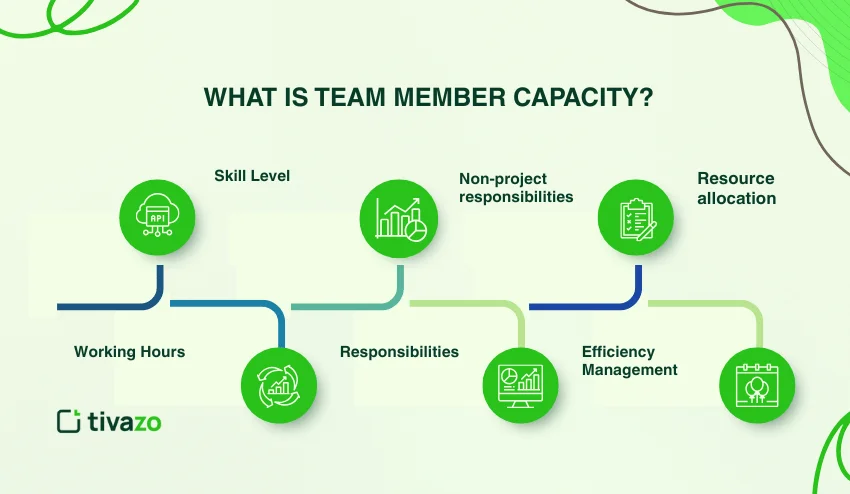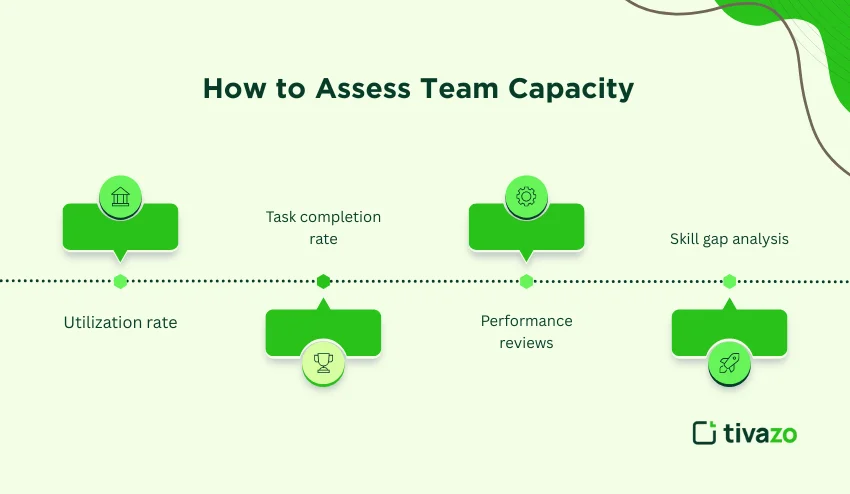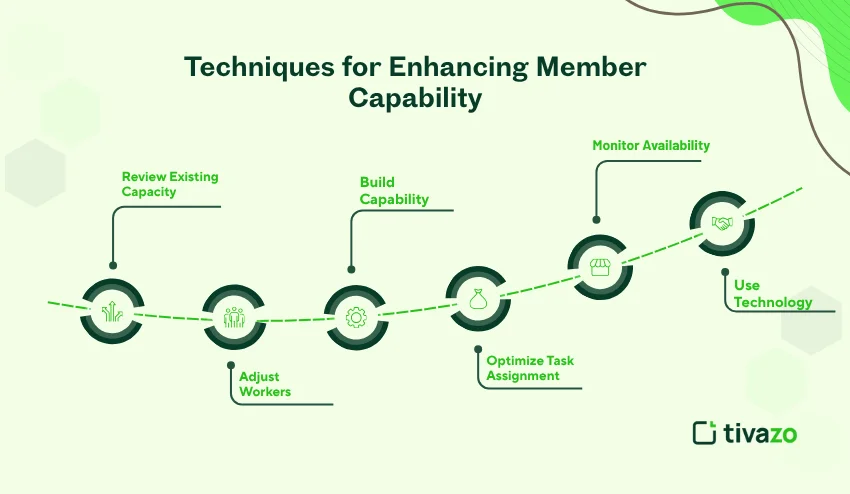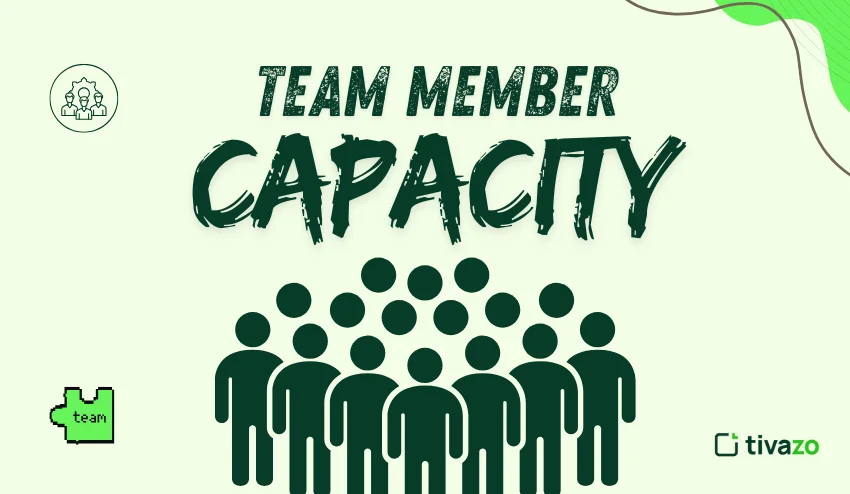Effectively leading a team involves more than simply outlining the work to be done. Understanding team member capacity is a crucial piece of the puzzle. Knowing how much work each team member is capable of doing means that not only do projects come to a timely conclusion, but also productivity is maximized and employee burnout is minimized. Additionally, by having a sense of team member capacity, you will be able to quickly identify opportunity gaps, realize service resource allocation efficiency, and generate overall team cooperation.
It has never been easier to work through first principles using capacity as a baseline to make data-based management decisions, set realistic deadlines, and create a work environment supporting the team. This guide will show you everything you need to know to understand team member capacity, including capacity definition, calculations, evaluation of capacity, possible strategies to improve, and best practices and strategies.
What is Team Member Capacity?
Team member capacity is defined as the amount of work a team member can complete over a designated period of time without sacrificing quality and productivity. When looking at capacity, it can include working hours, skill level, responsibilities, and other non-project-related responsibilities. This metric is essential for managers to understand how to allocate assignments appropriately, to avoid overloading staff, and to improve team performance. Key concepts include:
- Working Hours: Overall total hours available for productive work.
- Skill Level: An individual’s competency and experience can impact how quickly tasks can be accomplished.
- Responsibilities: Any core duties and additional project-related responsibilities that will be completed.
- Non-project responsibilities: Meetings, training, and administrative work, which can take away from overall capacity.
- Efficiency Management: This can help an organization balance productivity and avoid breaking points when overworked.
- Resource allocation: Assigning the right tasks to the right staff.

Why It’s Important to Understand the Members of Your Team’s Capacity
It is important to understand a team member’s capacity for performance to be able to build a highly effective team that operates smoothly.
- Maximized productivity: Creates a space where each team member can work at a sustainable speed without feeling stressed, and allows them to operate with fewer mistakes because they are not overwhelmed with competing priorities.
- Improved planning: Helps to gauge realistic timelines for work in learning, avoiding delays and last-minute efforts to push, pull, and transition.
- Better balance of workload: Keeps a team member from being inundated with work, and establishes an even distribution of work across all team members.
- Higher quality of work: Makes it so that a team member capacity can focus on doing their best work and not focus on rushing through tasks.
An understanding of a team’s capacity also aids in strategic planning and discussions. It helps ensure that resources can be allocated effectively, skill gaps are identified, vacations planned, and workload surges are anticipated. Understanding a team member’s capacity for work also enhances employee satisfaction and retention efforts.
Team member capacity will feel good about their work when they see that they can handle their responsibilities well and that their workload is manageable. That is what capacity planning is about: keeping a healthy, collaborative workforce while meeting the needs of achieving desired outcomes without sacrificing wellness.
Team member capacity calculation is important to plan the project accurately.
Follow these steps:
1. Document who all the team members are and their roles.
2. Determine available hours (total hours – vacation + holidays + breaks).
3. Calculate workload for each individual based on all this information (workload is task x task hours).
4. Calculate total team capacity by adding individual capacity.
Example table for team member capacity calculation:
| Team Member | Weekly Hours | Non-Project Hours | Available Hours |
| Alice | 40 | 5 | 35 |
| Bob | 40 | 8 | 32 |
| Carol | 40 | 4 | 36 |
| Total | 120 | 17 | 103 |
How to Assess Team Capacity
Assessing the capacity of team member capacity will help ensure effective use of resources and uncover areas for improvement. Please consider the following options:
- Utilization rate: This is the percentage of hours available for productive work. The utilization rate will help you identify team members who are underutilized or overworked.
- Task completion rate: You can calculate the task completion rate by checking how many tasks were assigned versus completed. This will give you a rough measure of efficiency and help you identify bottlenecks.
- Performance reviews: In performance evaluations, you examine individual efficiency, collaboration, and quality of work in relation to your team’s goals.
- Skill gap analysis: In doing a skill gap analysis, you look closely at where team members need training or additional resources. This will help ensure the team has the skills to meet the project demands.

You can also assess capacity through feedback sessions, where team members capacity can discuss their challenges and provide suggestions, and workload analysis, which examines how tasks are distributed and the deadlines for each task. Monitoring capacity over time enables a manager to reassess assignments, avoid burnout, and maximize output.
In addition to the information from evaluating capacity, a dashboard or timesheet can provide you with a more objective and real-time assessment of the team’s capacity. Periodic team evaluations lead to continual improvement, better team engagement, and meeting the expectations for high-quality work.
Ideal Team Composition
The number of individuals on a project team has a direct impact on total team member capacity and efficiency in accomplishing project objectives.
- Small projects where the team can be composed of 3–5 members allow for faster deliberation among team members, more efficient communication patterns, and easier coordination of team member capacity and responsibilities.
- Medium-sized projects can be composed of 6–10 members, which is ideal for dividing work up, yet not allowing the team to become too large for efficient communication.
- Large projects composed of 10–15 members should create sub-teams to avoid confusion and to manage accountability in the project.
Having the ‘optimal’ team size allows for optimal communication and accountability, while fostering collaboration and shared responsibilities. When the team is overstaffed, individuals are confused when asked to make decisions. Slower decisions are made, and human beings do not perform at optimal performance expectations.
Should the team become understaffed, the opposite will happen – and the remaining personnel may quickly experience burnout. The right team size should be determined by the complexity of the project. Determining and optimizing the right team size is important in order to achieve maximum team member capacity for your project tasks, with an efficient end delivery.
How Individual Skill Levels Impact Capacity
- The skills possessed by individuals play a key role in defining the capacity of team members, and therefore the efficiency of the team as a whole.
- Individuals with higher skill levels will complete work more quickly and accurately, enabling the team to take on additional work without sacrificing quality.
- Delayed skill levels may cause slow progression, bottlenecks, and reduced efficiency and speed, where other team members are reliant on the work of individuals with skill levels in certain domains.
- Cross-training provides both depth and flexibility, allowing team members to absorb multiple roles and adjust workloads given fluctuating peaks in volume or absent team members.

Investment in skill development through formal training, mentorship, and sharing of knowledge to enhance the performance of individuals or advantage collective capacity of the team. A highly skilled team can provide versatility in adapting to new tasks, can perform complex tasks with confidence, and remain productive between deadlines and fluctuating project demands. As a result, no single team member capacity must rely heavily on certain role responsibilities/responsibilities that can be a bottleneck for projects. As a result, project teams become more adaptive and productive.
Influence of Holidays, Vacations, and Time Away
Holidays, vacations, and other times away can significantly influence team member capacity and should be considered carefully while managing the project.
- Reduced capacity: Increased time away can reduce the working hours of team member capacity and may influence deadlines and the timeliness of a project.
- Task assignment: Observation may require a manager to reassign assignments temporarily so that work continues “without flattening” other team members.
- Planning: Keeping leave calendars and anticipating time away allows a manager to effectively plan for workloads without interruptions to the timeline at the last minute.
Finally, total consideration of time away will help prevent burnout and morale as employees feel valued and cared for. In addition, time away will facilitate a healthy work/life balance, which impacts long-term productivity. Including time away in capacity management will keep teams on track, ensure consistent productivity, and at least have shifts to an administrator to avoid energy fluctuations during times away.
Tools like project management software can help you visualize time away capacity during the project in real-time, therefore allowing for a smoother flow while members are still away.
How Team Capacity Planning Enhances Productivity
Team member capacity planning contributes to maximizing productivity, meeting deadlines, and keeping team member satisfaction levels high. Overall, it encourages:
- Balanced workload distribution: Tasks can be assigned based on availability, skills, and expertise, preventing overload to your team members.
- Realistic deadlines: Planning based on a capacity you can realistically meet reduces people’s anxiety about deadlines and the chance of re-work.
- Improved output quality: Team members can focus on providing quality results instead of rushing to complete tasks.
- Improved motivation: Balance in workload shows up when people are involved, motivated, and supported to take ownership of their tasks.
- Better allocation of resources: Capacity planning preserves resources by ensuring that designated team members are assigned per the project teams’ skill set.
- Identifying bottlenecks earlier: A manager can determine their team’s anticipated ability in terms of potential delays and/or capacity, before it impacts a project.
- Improved team collaboration: When workloads are balanced and team member expectations are set upfront, teams can work together more effectively.
- Continuous improvement: Capacity planning allows your organization to gather data to analyze member or team performance trends or optimize the future execution of projects.
- Reduced risk of burnout: Capacity planning considers not just workload balance but builds a system to prevent someone from constantly overworking during their employment to lessen work-life imbalance.
Strategic team capacity planning allows organizations to maximize team efficiencies while continuing to provide high-quality results with team member capacity and satisfaction, and productivity over time.
6 Techniques for Enhancing Member Capability
- Review Existing Capacity: Consider historical information and current capacity.
- Adjust Workers: Modify teams according to the complexity of the project.
- Build Capability: Cross-train team members to share responsibility across multiple roles.
- Optimize Task Assignment: Assign tasks on the basis of individual strength.
- Monitor Availability: Track time off and time for activities other than the project.
- Use Technology: Use software and collaborative tools to help track, plan, and report on project capacity.

Conclusion
It is essential to understand the capacity of your team member capacity to deliver projects efficiently, limit burnout, and support overall morale. When managers calculate, assess, and manage capacity appropriately, they can operate teams at their highest potential. Be sure to apply these concepts and utilize the right tools, combined with open and transparent communication, to create a motivated workforce.
In addition, frequently reviewing capacity metrics, addressing skills gaps, and anticipating contingencies like leaves or unforeseen adjustments will support project staffing efficiencies, overall execution, and build a team that can handle complexity without compromising quality and employee well-being.




